 We will start with the S&P 500 SPDR (SPY) and the S&P 500 EW ETF (RSP), two versions of the same 500 or so stocks. These are the most important benchmarks to watch when it comes to the broader market. As such, I will use these to set the benchmark highs and lows for ranking and grouping my curated ETF universe.
We will start with the S&P 500 SPDR (SPY) and the S&P 500 EW ETF (RSP), two versions of the same 500 or so stocks. These are the most important benchmarks to watch when it comes to the broader market. As such, I will use these to set the benchmark highs and lows for ranking and grouping my curated ETF universe.
SPY hit a 52-week high in July, formed two equal highs (peaks) in the 302 area and established support with the August lows (trough) in the 282 area. ETFs that exceeded their July high with 52-week highs are leading. ETFs that held their August lows are, well, holding up. ETFs that did not hit 52-week highs in the last few months, did not exceed their July high and did break the August lows are lagging. Stay away from this latter group.
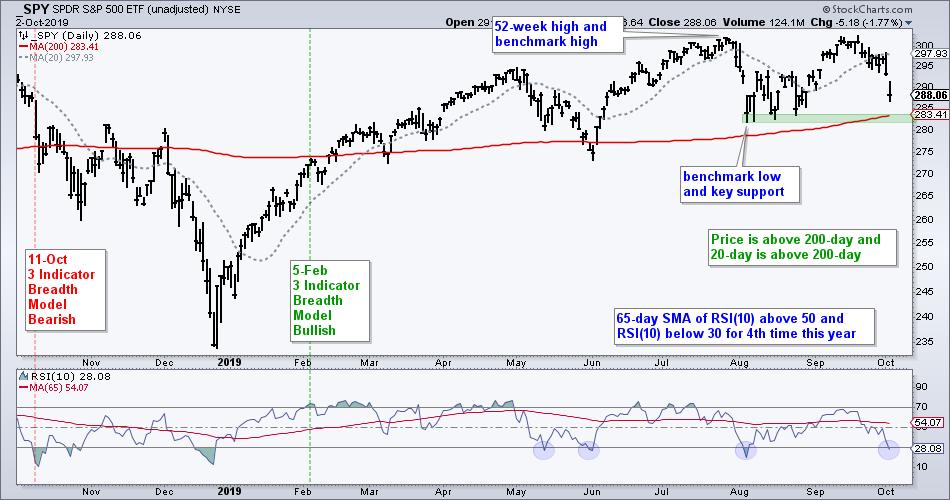
Before looking at RSP, note that SPY remains in an uptrend overall with key support in the 282 area. A close below 282 would break the August low, break the 200-day SMA and confirm a potential Double Top. Until these breaks actually occur, the trend is still up and SPY is short-term oversold as RSI(10) dipped below 30 for the 4th time this year. With support close at hand, this oversold condition could pave the way for a short-term bounce.
The next chart shows the S&P 500 EW ETF, which reflects the performance of the "average" stock in the S&P 500. First, notice that RSP is already testing its 200-day SMA. SPY remains above its 200-day and this means RSP is not as strong.
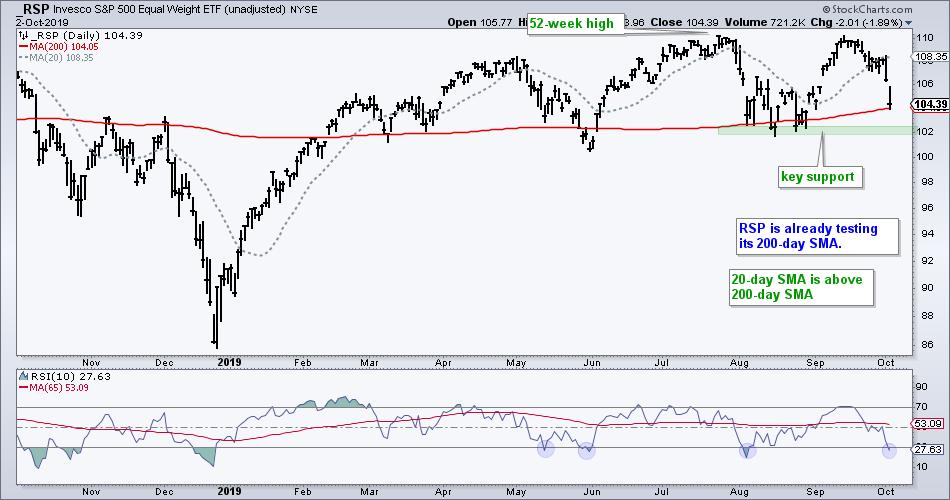
Despite less strength, RSP is in an uptrend overall because we have yet to see a lower low (support break), the 20-day SMA is above the 200-day SMA and the 65-day SMA of RSI(10) is above 50. Watch these three items for signs of a bigger trend change.
Overall, SPY and RSP are consolidating within a bigger uptrend. While a consolidation within an uptrend is typically a bullish continuation pattern, these patterns can also mark a top. At this point, we must wait for the pattern to be resolved with an upside breakout or downside break. Right now the swing within the pattern is down and this favors a downside break.
------------------------------------------------------------
Group Summary
Group 1: Uptrends and Leading
USMV, XLP, XLU, XLRE, ITB, XHB, SOXX, KIE, IYR, ITA, GLD, SLV, VIG, PFF, AGG, TLT, TIP, MBB, MUB, UUP
Group 2: Consolidating or Topping?
SPY, QQQ, MTUM, XLK, XLY, XLF, XLI, XLC, TAN, IHI, HYG
Group 3: Relatively New Downtrends
FDN, FINX, HACK, SKYY, IGV
Group 4: Multi-month Downtrends or Ranges
MDY, IWM, IJR, XLV, KRE, KBE, REM
Group 5: Strong Downtrends
XLE, XRT, IBB, XBI, IHF, MJ, XES, XOP, XME, FXE
------------------------------------------------------------
Group 1: Uptrends and Leading
The first group represents the leading ETFs. These recorded 52-week highs in the last few months, recorded higher highs from July to September and held above their August low. There are still a few equity-related ETFs, but there are also a lot of bond-related ETFs. In addition, the defensive sectors and gold are still in the leadership group. Let's start with the 20+ Yr Treasury Bond ETF (TLT) and Gold SPDR (GLD).
TLT is in a long-term uptrend. The ETF hit a 52-week high in early September and remains well above the rising 200-day SMA. The 65-day SMA of RSI(10) is also above 50.
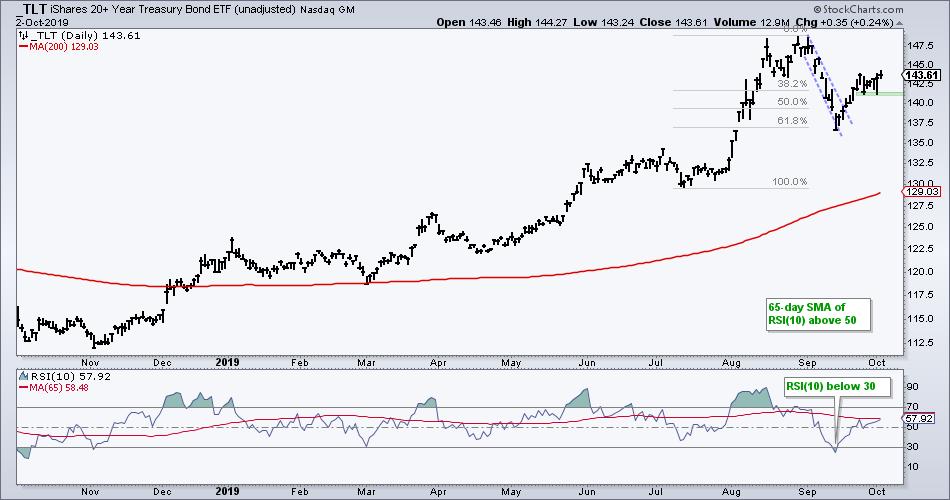
TLT corrected hard in the first half of September and then reversed at the 61.8% retracement in mid September. The short-term trend is also up with the late September and early October lows marking first support. A break would reverse this upswing and suggest another leg lower for this correction, perhaps an Elliott ABC correction would unfold.
GLD is in an uptrend overall for the same three reasons (52-week high in early September, price above rising 200-day and 65-day SMA of RSI(10) above 50).
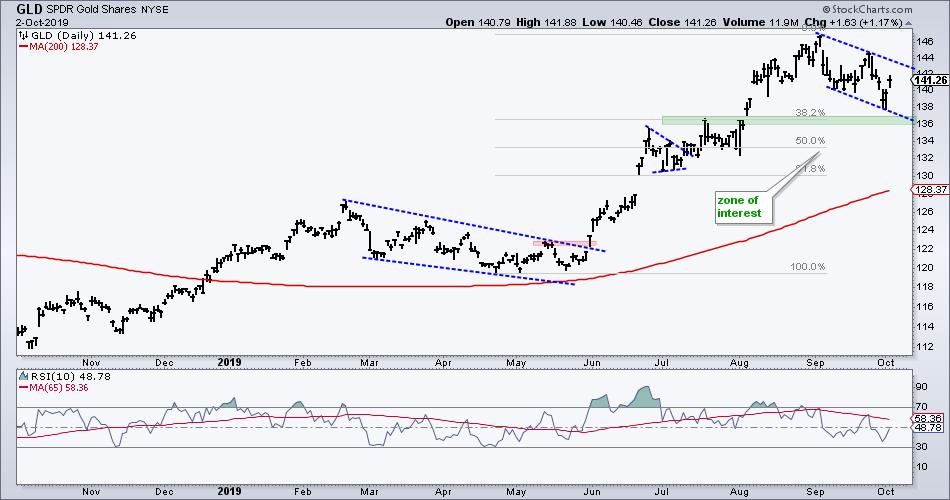
Short-term, GLD is in correction mode with a falling flag taking shape. The ETF retraced around 1/3 of the prior advance with the decline to 138 and then forged a short-term reversal the last four days. Further gains above 143 would break the flag line and signal a continuation higher.
The three defensive sectors (XLP, XLU and XLRE) are still in uptrends, but all three were hit with selling pressure the last two days. XLU broke away from the pact as the only one to hit a new high in late September. XLP and XLRE formed slightly lower highs over the last few weeks. Even though these lower highs are not enough to reverse the overall uptrends, they show that even defensive sectors can become vulnerable.
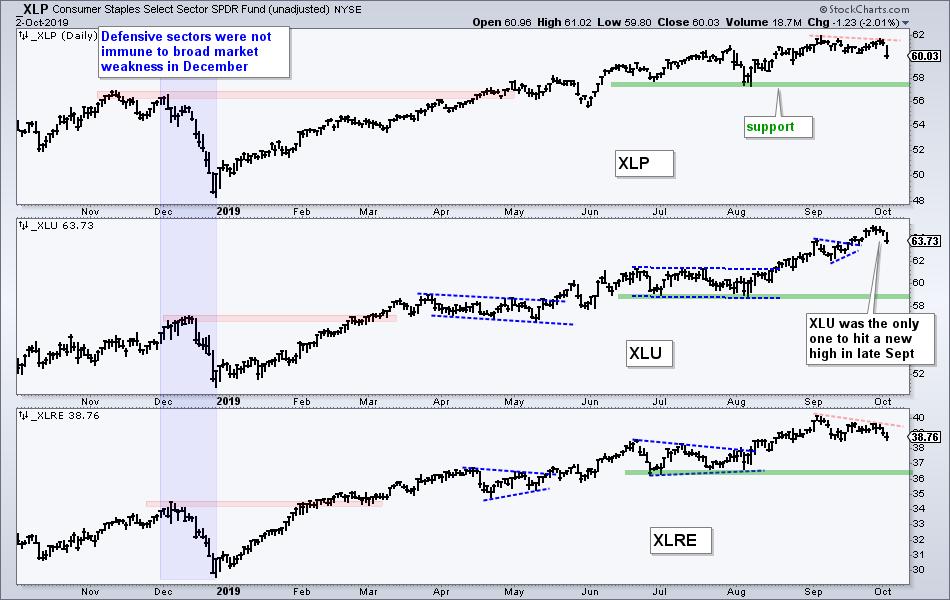
Also note that correlations rise when broad market conditions deteriorate. These three held up in November 2018, but succumbed to broad market selling pressure in the second half of December. Even though the current market environment is not at the December 2018 levels, it is something to consider if we see further deterioration in SPY, RSP and the breadth models, which will be updated on Saturday.
The next five ETFs represent a mix of industry groups and styles. All five are in uptrends because they hit new highs in September and remain above their August lows (key support). The Home Construction ETF (ITB) and Preferred Stock ETF (PFF) are leading the group because they have the most recent new highs (late Sept) and their declines were modest over the last two days.
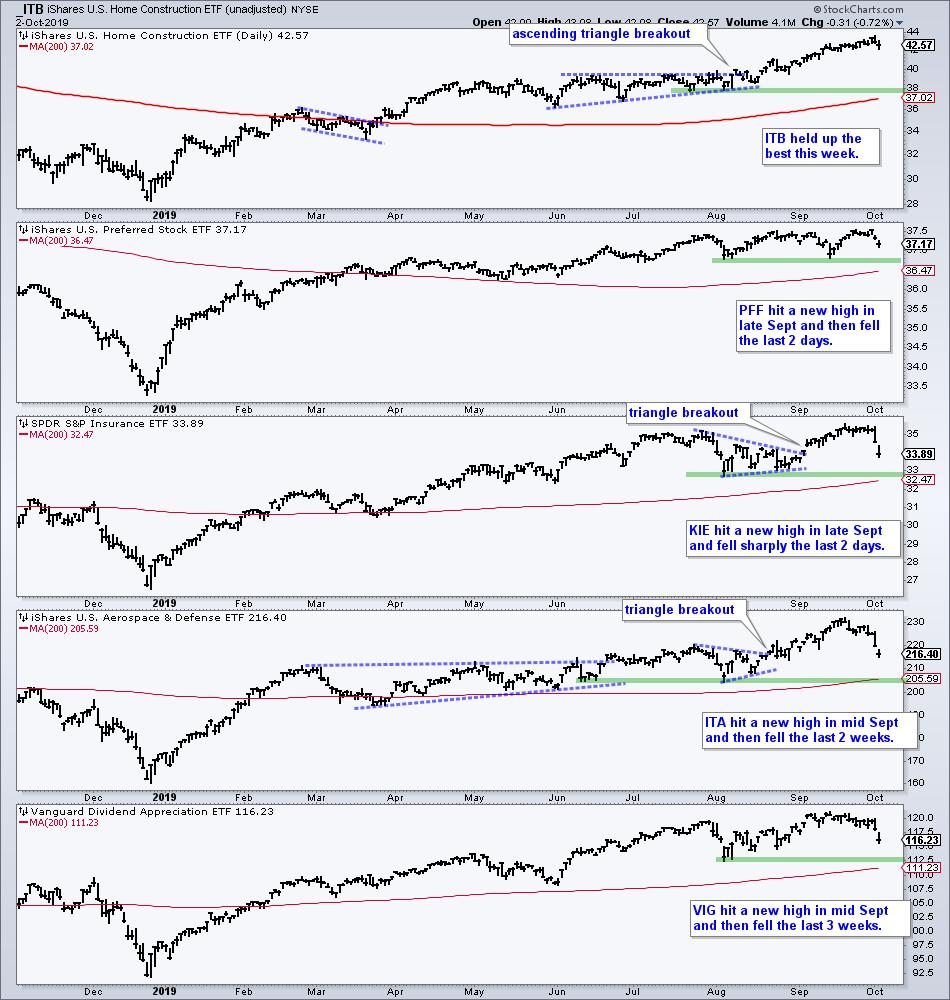
The Insurance ETF (KIE), Aerospace & Defense ETF (ITA) and Dividend Appreciation ETF (VIG) hit new highs in mid September. All three fell pretty sharply the last two days and are not immune to broad market weakness. Nevertheless, they have yet to test their August lows and are holding up relatively well.
Note that I demoted the Solar Energy ETF (TAN) and Medical Devices ETF (IHI) to the next group because they are already testing their August lows.
ETFs in Uptrends: USMV, XLP, XLU, XLRE, ITB, XHB, SOXX, KIE, IYR, ITA, GLD, SLV, VIG, PFF, AGG, TLT, TIP, MBB, MUB, UUP
Note that I precede all my chart symbols with an underscore (_SPY) to chart unadjusted data, which is data without dividend adjustments. Dividend adjustments are good for seeing the total return picture, but I prefer unadjusted data for charting purposes. Dividend adjustments add the dividend back to the price. This literally changes the historical data and creates an upward skew. Looking for an example? Compare SPY with _SPY over a 20 year period.
------------------------------------------------------------
What about the SOXX?
The Semiconductor ETF (SOXX) remains in an uptrend, but does not seem to fit in group 1 or group 2. SOXX hit a new high in July, challenged that high in mid September and then corrected. The ETF remains well above the August lows, above the 200-day SMA and the 65-day SMA of RSI(10) is above 50. The trend is still up and the decline over the last few weeks looks like a bull flag. Also notice that the 61.8% retracement is coming into play for the third time since May. A breakout at 216 would be bullish.

------------------------------------------------------------
Group 2: Consolidating or Topping?
The next group have yet to reverse their uptrends, but they are clearly consolidating and moving sideways the last two to three months. These ETFs have slightly lower or equal highs from July to September and remain above their August lows. Note that SPY, RSI and the five offensive sectors are in this group.
The chart below ranks the five offensive sectors from top to bottom. The Consumer Discretionary SPDR (XLY) and Technology SPDR (XLK) are on top because they are the furthest above their August lows and both remain above their rising 200-day SMAs. The Finance SPDR (XLF) is in the middle because it is close to its 200-day and above the August low.
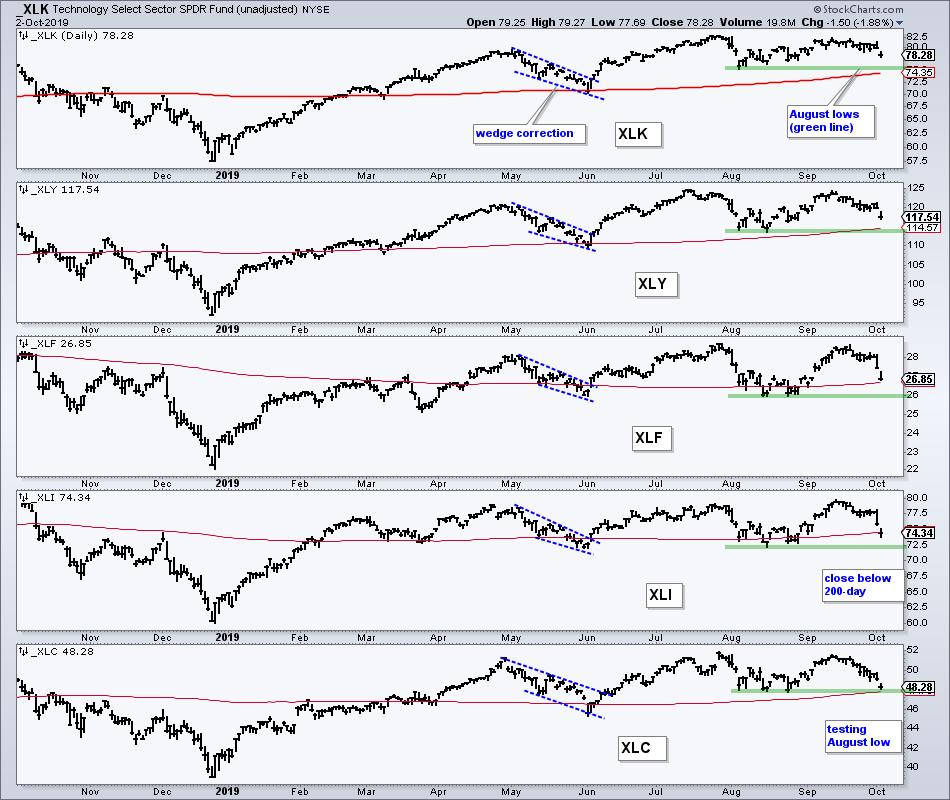
In the weaker half, the Industrials SPDR (XLI) closed just below its 200-day, but remains above its August low. The Comm Services SPDR (XLC) is trading at its August low, but remains above the 200-day SMA.
Ranking is not always black and white, but one level stands out: the August lows. These key sectors have yet to fully break down until they move below their August lows and forge lower lows. The S&P 500 is in good shape as long as the majority hold. Watch out if 3 or more break their August lows.
ETFs Consolidating: SPY, QQQ, MTUM, XLK, XLY, XLF, XLI, XLC, TAN, IHI, HYG
------------------------------------------------------------
Group 3: Relatively New Downtrends
Now we get into the weak side of the ETF universe with some relatively new downtrends. The next group of ETFs formed lower highs from July to September and recently broke their August Lows. These ETFs also show relative weakness from August to October.
The chart below shows five tech-related ETFs ranked by performance. IPAY broke below its August low, but remains well above the rising 200-day SMA. Despite the support break, the decline from the July high could still be a correction within a bigger uptrend. Keep an eye out. The FinTech ETF (FINX) is a bit weaker than IPAY because it is already testing its 200-day SMA.
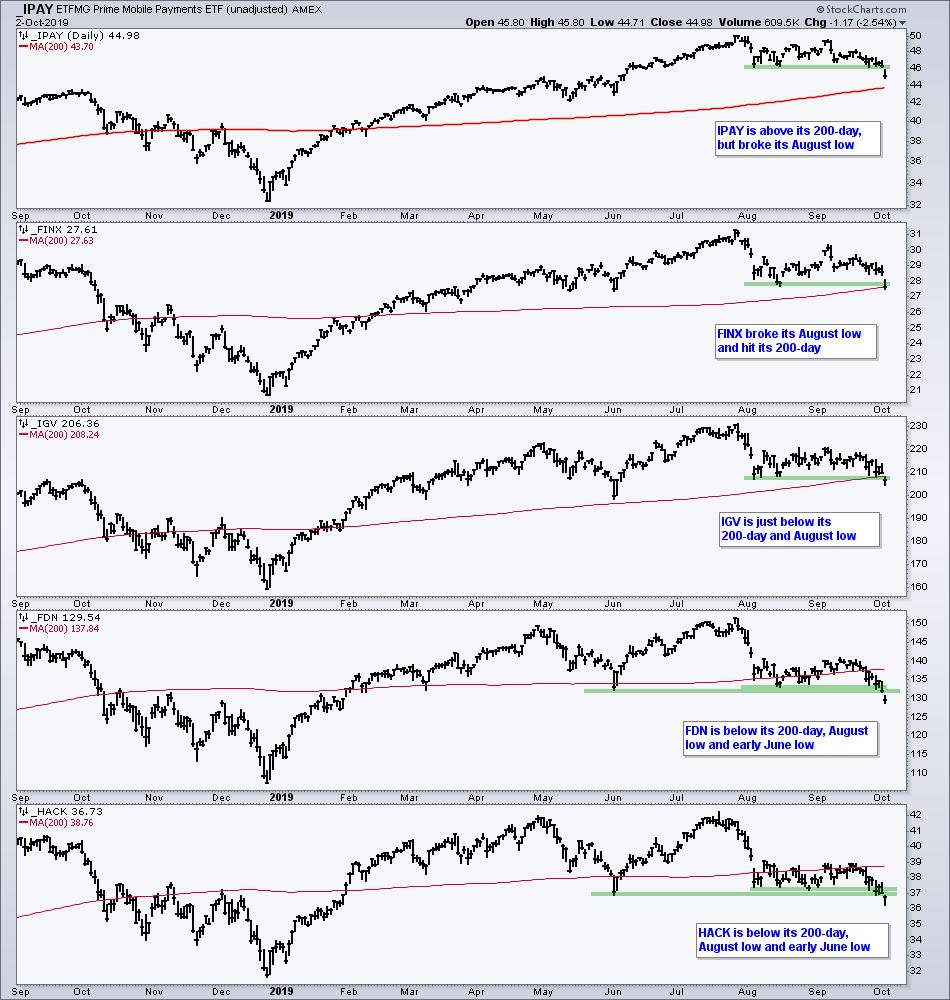
The Software ETF (IGV) broke below its August low and 200-day SMA with a decline on Wednesday. The Internet ETF (FDN) and Cyber Security ETF (HACK) are the weakest of the group because they broke their early June lows and are the furthest below their 200-day SMAs.
New Downtrends: FDN, FINX, HACK, SKYY, IGV
------------------------------------------------------------
Group 4: Multi-month Downtrends or Ranges
The next group of ETFs are either in downtrends for several months or trading ranges. Either way, they are clearly NOT in uptrends and clearly lagging. I am not interested in ETFs that are trending lower AND lagging.
The chart below shows the Russell 2000 ETF (IWM), S&P SmallCap 600 SPDR (IJR) and S&P MidCap 400 SPDR (MDY). IWM and IJR sport lower lows and lower highs for several months. MDY is flat, but the ETF is by no means in an uptrend and by no means a leader.

The blue line marks the early December high (2018). All three are back below this high. I do not consider this a resistance level, but it does mark a performance benchmark of sorts. ETFs that could not hold above their early December highs are clearly lagging in 2019.
The next chart shows the Regional Bank ETF (KRE) and Bank SPDR (KBE) working their way lower since March with a series of lower lows and lower highs. These three have been below their December highs since May. Talk about underperformance.
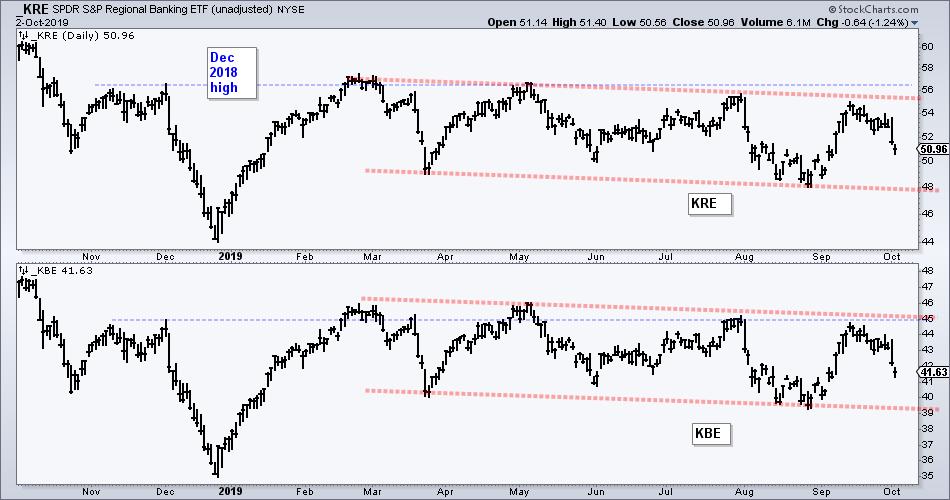
Downtrends or Ranges: MDY, IWM, IJR, XLV, KRE, KBE, REM
------------------------------------------------------------
Group 5: Strong Downtrends
The next group of ETFs are in the strongest downtrends. All are below their 200-day SMAs. The Biotech ETF (IBB) and Biotech SPDR (XBI) moved below their early June lows. The Alternative Harvest ETF (MJ) and Euro ETF (FXE) hit 52-week lows, though I do not think these two are related.
In a testament to the worthlessness of geopolitical news, the chart below shows the Energy SPDR (XLE) failing to hold above its 200-day SMA in mid September and falling back towards the August lows. The Oil & Gas Equipment & Services ETF (XES) and Oil & Gas Exploration & Production ETF (XES) never came close to their 200-day SMAs on this dead-cat bounce and are already back to their August lows.
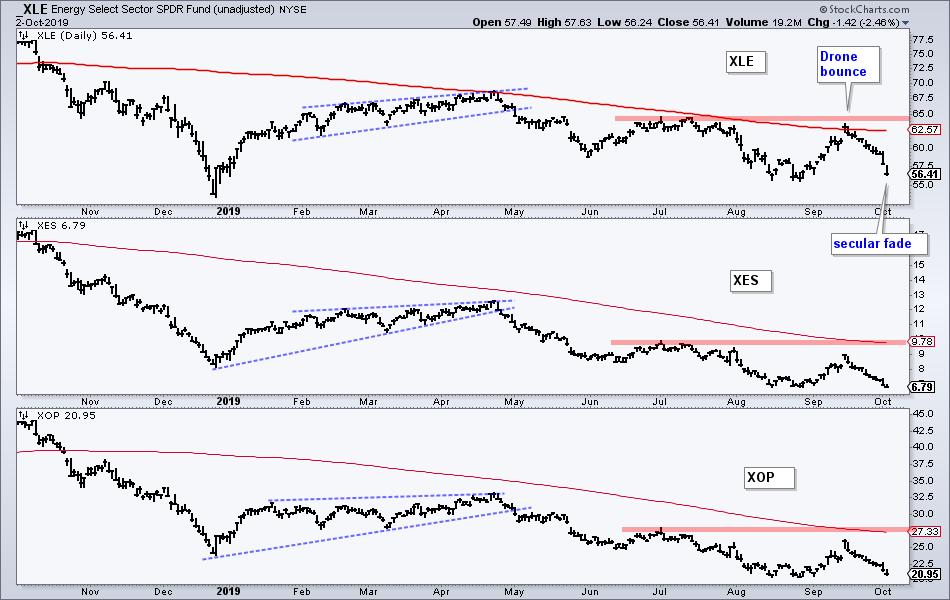
Strong Downtrends: XLE, XRT, IBB, XBI, IHF, MJ, XES, XOP, XME, FXE
------------------------------------------------------------
Choose a Strategy, Develop a Plan and Follow a Process
Arthur Hill, CMT
Chief Technical Strategist, TrendInvestorPro.com
Author, Define the Trend and Trade the Trend
Want to stay up to date with Arthur's latest market insights?
– Follow @ArthurHill on Twitter






